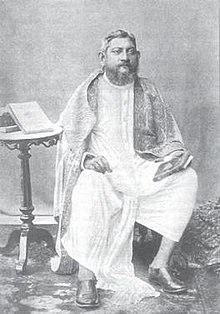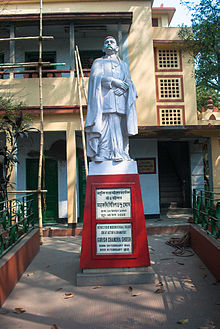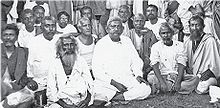Girish Chandra Ghosh
Girish Chandra Ghosh | |
|---|---|
গিরিশচন্দ্র ঘোষ | |
 | |
| Born | 28 February 1844 |
| Died | 8 February 1912 (aged 67) |
| Nationality | British Indian |
| Alma mater | Hare school Oriental Seminary |
| Occupation(s) | Actor, director, and writer |
| Spouse | Pramodini Devi |
Girish Chandra Ghosh (28 February 1844 – 8 February 1912) was a Bengali actor, director, and writer. He was largely responsible for the golden age of Bengali theatre.[1][2][3] He cofounded the Great National Theatre, the first Bengali professional theatre company in 1872, wrote nearly 40 plays and acted and directed many more,[4] and later in life became a noted householder disciple of Sri Ramakrishna.[5]

Biography
[edit]
Early days
[edit]Born in Bagbazar, Kolkata, on 28 February 1844,[6] the eighth child to his parents Nilkamal and Raimani, he received his early education at Oriental Seminary, and later studied at Hare School in the city but did not complete his education. His father Nilkamal Ghosh was a generous and kind-hearted person, and Girish retained some of his father's large heartedness. Girish said of his parents, "My father was an expert accountant and had a tremendous managerial capacity and worldly wisdom. My mother was very gentle and had great devotion for God... I inherited from my father a sharp intellect and pragmatic approach to life, and from my mother a love for literature and devotion to God" [7] He lost his parents early in life and went on to educate himself. After the death of his father he married Promodini Devi, the daughter of Nabin Chandra Deb and re-entered in class - I in the Oriental Seminary. After leaving school in 1862, Girish acquired an apprenticeship with a British Company in bookkeeping.[8] It was around this time that Girish became acquainted with Ishwar Chandra Gupta and began writing plays, songs and poetry.[9]
Professional career
[edit]
Girish was a prominent actor in the Bagbazar Amateur Theatre where he had Ardhendu Sekhar Mustafi, another great contemporary actor, as his partner. Together they performed in Sadhabar Ekadashi by the famous playwright Dinabandhu Mitra, which became very popular. Later, Bagbazar Amateur was renamed in 1871 as the National Theatre. However, Girish left the National Theatre and went on to form the Great National Theatre in 1873. In 1877 Girish staged his first play Agamani there.[9] Later he also worked at the Minerva Theatre and went on to become the manager. In 1883 Girish opened the Star Theatre with his own money and managed it under his direction.[10] The first play produced at the Star Theatre was Daksha Jagna by Girish Chandra Ghosh on the auspicious day of 21 July 1883. With Binodini Dasi, he staged his play, Chaitanyalila, at the Star Theatre on 20 September 1884, with Sri Ramakrishna in the audience.
Girish wrote about 86 plays, most of which were based upon stories from Purana, Ramayana and Mahabharata. Among his famous works were Buddhadev Charit, Purna Chandra, Nasiram, Kalapahar, Ashoka, Shankaracharya, Chaitanyalila, Nimai Sannyas, Rup-Sanatan, Vilwamangal, Prahlad Charit. Most of his plays were performed in Star Theatre in Calcutta.[11] Girish also translated Shakespeare's Macbeth play into Bangla in 1893.[9]
Influence of Sri Ramakrishna
[edit]Girish first met Sri Ramakrishna in the ancestral home of his neighbour Kalinath Bose. On 21 September 1884 Sri Ramakrishna went to watch Chaitanya Lila in the Star Theatre. It is said that Girish's first meeting with Sri Ramakrishna, was not very cordial. He saw Sri Ramakrishna in divine ecstasy and thought it to be some kind of a trick. But later when Ramakrishna met him the Master told him that the incident was no trick and Girish was extremely surprised to find master reading his thought. Later when the Master went to visit his theatre he and Girish repeatedly went on exchanging salutes and ultimately Girish had to give up. Girish later said about this incident that in this Iron Age the best weapon is "pranamastra" or the "salute weapon" with which god kills His enemies. In his play Nasiram, Girish used much of the teachings of Sri Ramakrishna.[12] There are many scenes in The Gospel of Sri Ramakrishna involving Girish and Sri Ramakrishna.[13] Sri Ramakrishna went to watch several of his plays in Star Theatre. He also blessed Binodini Dasi, one of the lead actresses.
Many of the followers of Sri Ramakrishna were shocked that Girish was held in such high regard by the Master. Girish was known to visit houses of prostitution, get falling-down drunk, and even curse Ramakrishna, yet he came to regard Ramakrishna as an Avatar.[14]
Power of Attorney
[edit]After testing Sri Ramakrishna for years, seeking to find fault or hypocrisy, but finding none, Girish finally asks what spiritual practices to adopt.
Ramakrishna answered, "Try and call on God three times a day."
Girish says, "I'm sorry. I can't promise to. I may forget."
Then the Master said, "Do it twice a day. Do it once."
Girish, in dismay, "No, no, I can't promise anything."
Finally, Ramakrishna says, "All right, then give me your Power of Attorney.[15] I'll be responsible for you. Now you have no will at all. You will only say, 'I do whatever the Lord wills'. Don't ever say again, 'I will do this' or 'I will do that'.[16]
At first, he felt relieved, thinking he could go on doing whatever he liked. But slowly he came to realize that he had to be honest with himself and ask, is this something God wants me to do, or just my lower nature?[17]
Christopher Isherwood and Girish Ghosh
[edit]World famous English author, Christopher Isherwood was a beloved disciple of Swami Prabhavananda, and closely identified with Girish who wrote and gave lectures on the Bengali playwright. Isherwood, in his biographical book, My Guru and his Disciple said, "Girish became a kind of patron saint for me - I felt closer to him than any other member of the Ramakrishna circle.[18]"
In December 1975, Isherwood gave the Sunday lecture at the Santa Barbara Vedanta Temple titled Girish Ghosh, where he describes the parallels in their two lives - coming from a state of worldly drunkenness and debauchery to accepting the teachings of a Holy Man, who offered them unconditional love and brings them to God.
References
[edit]- ^ Nalini Natarajan; Emmanuel Sampath Nelson (1996). "Drama 1900 -1926". Handbook of twentieth-century literatures of India. Greenwood Publishing Group. p. 48. ISBN 0313287783.
- ^ Kundu, Pranay K. Development of Stage and Theatre Music in Bengal. Published in Banerjee, Jayasri (ed.), The Music of Bengal. Baroda: Indian Musicological Society, 1987.
- ^ Sisir Kumar Das (1991). History of Indian Literature: 1800–1910 : Western Impact, British Response. Sahitya Akademi. p. 283. ISBN 8172010060.
- ^ "Girish Chandra Ghosh". Encyclopædia Britannica. Archived from the original on 23 March 2012. Retrieved 27 March 2009.
- ^ Christopher Isherwood (1980). Ramakrishna and his disciples. Vedanta Press. p. 247. ISBN 087481037X.
- ^ Chetanananda, Swami (2009). Girish Chandra Ghosh, A Bohemian Devotee of Sri Ramakrishna. Vedanta Society of St. Louis. p. 12. ISBN 978-0-916356-93-4.
- ^ Chetanananda, Swami (2009). Girish Chandra Ghosh, A Bohemian Devotee of Sri Ramakrishna. Vedanta Society of St. Louis. p. 23. ISBN 978-0-916356-93-4.
- ^ Chetanananda, Swami (2009). Girish Chandra Ghosh, A Bohemian Devotee of Sri Ramakrishna. Vedanta Society of St. Louis. p. 34. ISBN 978-0-916356-93-4.
- ^ a b c "Ghosh, Girish Chandra". Banglapedia. Archived from the original on 25 February 2017. Retrieved 4 February 2017.
- ^ Isherwood, Christopher (1965). Ramakrishna and His Disciples. Methuen & Co. Ltd. p. 248.
- ^ Girish Chandra Ghosh Archived 19 February 2012 at the Wayback Machine
- ^ Contemporary Bengali Literature – I, by Hiranmoy Mukherjee, Vedanta Kesari, April 2010
- ^ Nikhilananda, Swami (1942). The Gospel of Sri Ramakrishna. Ramakrishna-Vivekananda Center, New York. p. 721. ISBN 978-0-911206-01-2.
- ^ Chetanananda, Swami (2009). Girish Chandra Ghosh, A Bohemian Devotee of Sri Ramakrishna. Vedanta Society of St. Louis. p. 21. ISBN 978-0-916356-93-4.
- ^ Isherwood, Christopher (1980). My Guru and His Disciple. Farrar Straus Giroux. p. 199. ISBN 978-0-374-21702-0.
- ^ Chetanananda, Swami (2009). Girish Chandra Ghosh, A Bohemian Devotee of Sri Ramakrishna. Vedanta Society of St. Louis. p. 18. ISBN 978-0-916356-93-4.
- ^ Chetanananda, Swami (2009). Girish Chandra Ghosh, A Bohemian Devotee of Sri Ramakrishna. Vedanta Society of St. Louis. p. 316. ISBN 978-0-916356-93-4.
- ^ Isherwood, Christopher (1980). My Guru and His Disciple. Farrar Straus Giroux. p. 196. ISBN 978-0-374-21702-0.
Further reading
[edit]- Chinmoy, Sri (1991). From The Undivine Tree to the Divine Fruit: Girish Chandra Ghosh.
- Dutta, Utpal (1992). Girish Chandra Ghosh. Sahitya Akademi. ISBN 817-201-197-0.
- Chetanananda, Swami (2009). Girish Chandra Ghosh: A Bohemian Devotee of Sri Ramakrishna. Vedanta Society of St. Louis. ISBN 978-0-916356-92-7.
- Isherwood, Christopher (1980). My Guru and His Disciple. Farrar Straus Giroux. ISBN 978-0-374-21702-0.
External links
[edit]- Bengali writers
- Bengali-language poets
- 19th-century Indian dramatists and playwrights
- Indian theatre directors
- Indian male stage actors
- 1844 births
- 1912 deaths
- Writers from Kolkata
- Lay disciples of Ramakrishna
- Bengali theatre personalities
- 19th-century Indian male actors
- People from British India
- Hare School alumni
- Oriental Seminary alumni
- Indian male dramatists and playwrights
- Indian male poets
- 19th-century Indian poets
- Dramatists and playwrights from West Bengal
- Novelists from West Bengal
- Poets from West Bengal
- Male actors from Kolkata

